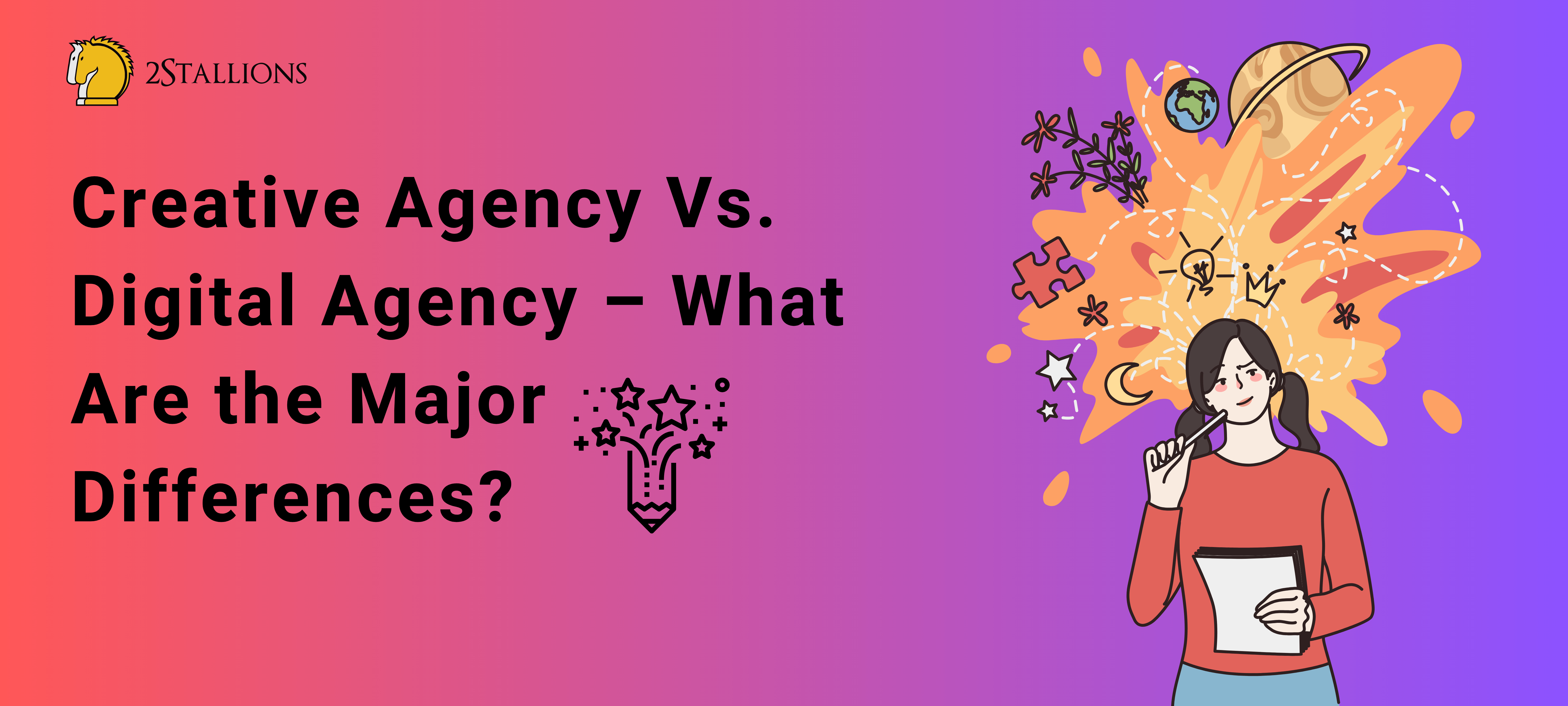Content
SHARE

What is the value of UI/UX design? In an era of digital acceleration, UI/UX is a particular set of design skills primed to be one of the fastest-growing careers.
The field of digital design is rapidly expanding across organisations, continually evolving and giving rise to new niches. User experience design, user interface design, customer experience, and product design are all part of the larger landscape of building user-friendly digital content. They are responsible for an intuitive, impeccable user experience that leads to easy navigation.
A well-designed user experience and a user-friendly interface make a website or app more engaging, trustworthy and accessible. Many companies seek UI/UX designers who can transform their business’s digital presence through optimised interfaces and improved usability.
UI/UX designers work as part of a broader product team and often find themselves bridging the gap between the user, the development team, and key business stakeholders.
[thrive_leads id=’8287′]
What Is The Difference Between UI/UX?
UI vs UX Design
User Interface (UI) and User Experience (UX) are different skill sets. The two roles have distinct differences in the problems they solve, the methodology used and the tools they adopt in their day-to-day job. We’ve come up with a table of elements consisting of the differences in focus, components, responsibilities, tools and goals for UI and UX:
UI |
UX |
|
Focus |
Primarily deals with the visual elements, graphic design theory, and overall design of a product, focusing on how it looks and feels to the user. | Focuses on the overall user’s experience when interacting with a product. It’s concerned with how the user feels and what is achievable. |
Components |
Includes elements like buttons, icons, colours, typography and overall layout. | Everything from user research, information architecture, wireframing, and prototyping to usability testing. |
Responsibilities |
Responsible for creating visually appealing and consistent interfaces, ensuring the design aligns with the brand’s identity. | Responsible for ensuring that the product is user-friendly, efficient, and provides value to the user. They improve the overall flow and functionality. |
Tools |
Adobe XD, Sketch, or Figma to create mockups and prototypes. | Axure RP, Balsamiq, or InVision for wireframing, prototyping, user testing, and research. |
Goals |
Make the product visually appealing, easy to understand, and visually consistent. | Create a seamless and satisfying user experience, ensuring users can achieve their goals efficiently. |
The symbiotic relationship between User Interface (UI) and User Experience (UX) design is nothing short of vital for the success and growth of any business. These two aspects work hand in hand, creating a dynamic duo that ensures the final product, whether it’s a website, a landing page, a mobile application, or any digital platform, is not just functional but thrives in today’s competitive landscape.
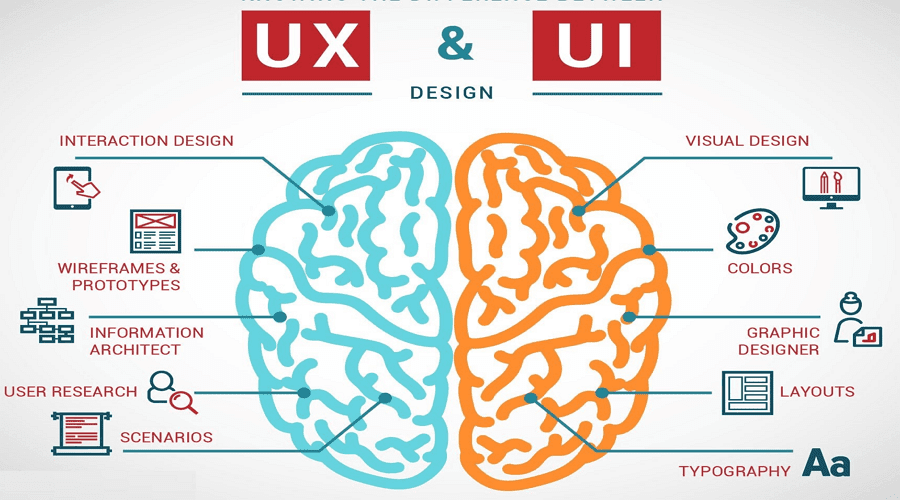
UX: User Experience
As the name suggests, UX designers are dedicated to user experience and are primarily “user first” in all their work. UX designers are responsible for ensuring the user finds information and easily takes action (such as making a purchase or booking an appointment). The UX designer is concerned with arranging information presented to users as they scroll through an app or website. UX professionals must prioritise content and place pieces of information strategically throughout a page.
Through user research, the UX designer will collect user profiles to gain insights into their needs and preferences. With this information, the designer then plans the content and site structure to cater to the users. This process, also known as user flow, creates different ways a user will likely navigate the site. The next step would be to sketch wireframes and develop prototypes based on the wireframes.
Wireframes are the basic skeletal structure of a website or app, allowing a UX designer to outline and map out user flow. A prototype (a mockup of a site or app) is then created and tested with users to collect feedback and fine-tune the product before the actual development.
Even after a product is completed, UX design doesn’t stop there. Any app or website must be refreshed occasionally to account for evolving search trends and ever-changing user behaviour. UX designers must continuously consider the shifting needs of both consumers and businesses to enhance the platform. Think about renowned social media platforms such as Facebook, YouTube and Instagram. Has your user experience changed and improved drastically over the years?
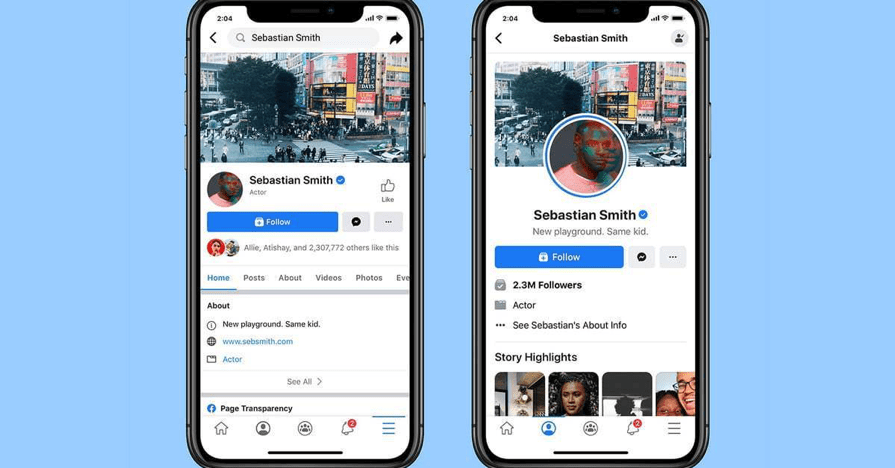
UI: User interface
UI is a digital space where users see and perceive information visually. It is concerned with interactive elements such as drop-down menus, form fields, clickable elements, animation, button styling and other critical tools in UI design. These are elements that will guide a user’s engagement with a product. UI designers take the framework and wireframes created by the UX designer and translate them into high-fidelity, final visual deliverables before handing them off to a development team for production.
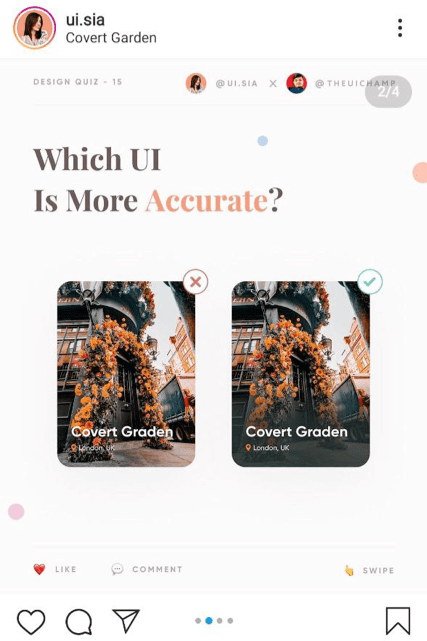
A vs B: Image B uses a gradient mixture to ensure the location mark can be seen better.
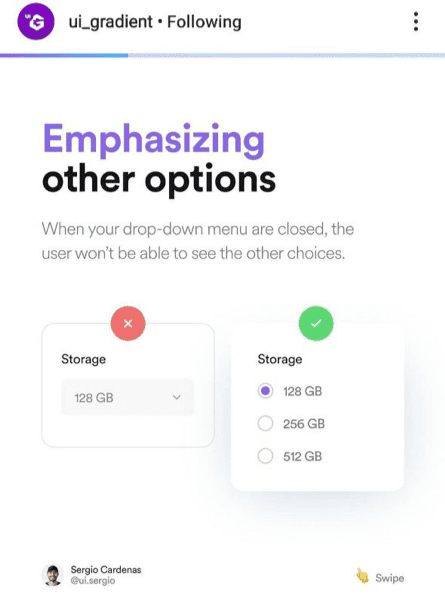
UI designers have to determine which visual element to use to guide a user to take action.
UI/UX Is Invaluable For Efficient Product Design
UI/UX designers are central to the creation of user-friendly designs. By understanding how different psychological principles influence human behaviour, UI/UX professionals design websites, apps and other products for a hassle-free browsing or shopping experience. Essentially, they’re responsible for creating human-centred designs for real users in the real world. Using the example of a cup illustrates the importance of UI and UX in any product design.
UI determines the appearance of the cup–in the form of a cute animal that appeals to consumers looking to buy a nice cup. The cup has a handle, signalling there is where they hold the cup. However, a lack of good UX design failed to account for the animal’s ears, posing a hazard to the person using the cup.

While UI and UX are distinct disciplines, they are inseparable when creating a digital product that works and excels. Businesses that recognise the significance of this synergy can harness it to grow and flourish in a customer-centric digital age. Understanding the unique roles and responsibilities of UI and UX designers is just the first step in unleashing the full potential of this powerful partnership.
Example of Good UI/UX – Zalora Mobile Shopping App
Zalora Group is a leading online e-commerce and fashion retailer in various Southeast markets. As Asia’s leading online fashion destination, ZALORA’s localised sites offer an extensive collection of top international and local brands and in-house labels across apparel, shoes and accessories for men and women. ZALORA aims to provide consumers in Asia seeking a shopping experience focused on their unique styles, trends and fit, hence its tagline ‘With Zalora, you own now”.
A Seamless Shopping Experience with Zalora Shopping App



The images show that Zalora’s mobile app has multiple interactive buttons tailored to a mobile shopping experience. Buttons are placed at convenient touchpoints for those holding their phone with one hand. All the necessary information is also easily accessible on the same page, preventing users from entering and exiting a page to find information.
Why UI/UX Important For Businesses
According to a McKinsey Report, the most innovative and successful companies dedicate 12–14% of their resources to enhancing their design abilities. From the Zalora example, we can see how humanised designs can provide value to their users. This value will eventually trickle down to higher user interactions, engagement, and customer satisfaction, which will further trickle down to an increased ROI (Return on investment) for a business. Forbes estimates suggest that every dollar invested in UX brings 100 dollars in return. That’s an ROI of nearly 10,000% increase!
Optimised For Faster Conversion
-
Conversion Optimisation
A well-structured UI/UX design streamlines the user journey, making it easy for customers to find what they need and complete their desired actions, such as purchasing. Clear and intuitive navigation and persuasive calls-to-action (CTAs) guide users through the conversion funnel. Simplified checkout processes, with minimal steps and distractions, can significantly boost conversion rates.
-
Lower Bounce Rates
High bounce rates often occur when users visit a website or app and encounter difficulties using or navigating it. Good UI/UX design ensures that users are greeted with an appealing, user-friendly interface that encourages them to explore further. When users can easily locate relevant information and interact seamlessly with the platform, they are less likely to bounce back to search results or exit the site/app.
-
Longer Dwell Time
Dwell time, the duration users spend on your platform, is valuable. UI/UX designers can contribute to longer dwell times by creating engaging and interactive elements. Features like personalised product recommendations, related articles, and easy-to-access information keep users engaged and encourage them to explore more content or products. The longer users stay, the more opportunities you have to convert them.
-
Personalised Shopping Experience
Personalisation is a key driver of customer satisfaction and loyalty. UI/UX designers can integrate features like product recommendations based on user behaviour and preferences. Sections like “You may also like this…” or “Recommended for you…” offer users tailored options, significantly increasing their chances of discovering products they love. This personal touch enhances the shopping experience, making users feel valued and understood.
-
Efficient Information Access
UI/UX design focuses on information architecture and layout, ensuring that essential details like shipping and payment options are easily accessible. This minimises user frustration and reduces the time it takes for customers to make informed decisions. Users who can find important information without hassle are more likely to proceed to checkout.
-
Interactive CTAs
Clear and compelling CTAs are essential for guiding users towards conversion. Well-designed buttons with persuasive text simplify the process of taking action, such as adding items to a wishlist, sharing products, or adding items to a cart. Interactive elements like hover effects or subtle animations can draw attention to these CTAs, encouraging users to move from consideration to purchase.
Build Your Customer Base & Brand Loyalty
-
Establishing Confidence and Credibility
In today’s digital landscape, your website or application is the initial point of contact between your business and potential customers. A well-designed UI immediately conveys professionalism and trustworthiness. When users encounter a website or app that looks polished, intuitive, and user-friendly, they are more likely to trust your brand and engage with your offerings.
-
Brand Recognition
Consistency in UI and UX design elements, such as colour schemes, typography, and visual style, contributes to brand recognition. When users encounter and interact with these elements across your digital platforms, it reinforces your brand identity in their minds. This familiarity can lead to brand recall and loyalty.
-
Standing Out in a Competitive Market
The digital landscape is saturated with competitors, making capturing and retaining customers challenging. A well-crafted UI and UX can be a differentiator. When your platform offers a superior user experience compared to competitors, you attract new customers and keep them engaged and loyal.
-
Winning Over Customers
A user-centric design approach, which is at the core of UX design, prioritises the needs and preferences of your target audience. You create an emotional connection with users by addressing their pain points and providing solutions. When users feel that a product or service understands and caters to their needs, they are more likely to choose your brand over others.
-
Repeat Business and Customer Retention
Whether it’s an eCommerce site, a mobile app, or a SaaS platform, a smooth and enjoyable user experience keeps users returning. UI and UX development are not just technical components of web development; they are strategic assets for building a thriving business. Investing in good UI and UX design creates a strong foundation for winning customer confidence, fostering brand loyalty, and ultimately growing your business in an increasingly competitive digital environment.
Creating Business Value with Good UI/UX Design
Customers are the lifeblood of your business, and they are the ones who sustain it. Therefore, designing a pleasant and intuitive user experience should be at the heart of every digital product. Failing to cater to their needs and desired shopping experience will only lead to losing opportunities and conversions for your brand.
- 90% of users reported they stopped using an app due to poor performance.
- 86% deleted or uninstalled an app due to problems with its functionality or design.
- 88% of online consumers are less likely to return to a site after a bad experience.
If your business is going digital, it’d be wise to invest time and money into creating and building digital products (websites, mobile apps, etc.) that provide a good user experience to reap the immense benefits it can provide for your business ROIs.
Discover more with 2S Creative Services
We are a full-service digital marketing agency based in Singapore. From strategy to execution, we provide personalised digital solutions, including creative services for over 300+ clients ranging from MNCs and government institutions to local SMEs. Recently, we’ve also been featured as one of Singapore’s 50 best creative agencies. If you’re looking for a web design expert, don’t hesitate to contact us.
Originally published: 17 July, 2020
Updated: 14 September, 2023
Boost Your Online Presence with Our Digital Creative Services in Singapore. Take advantage of our professional Digital Creative Services customized for your business and objectives to help you connect with your target audience, enhance your online visibility, and generate more leads. Contact us today!
Frequently Asked Questions on UI/UX Design
What Is UI and UX Designing?
UI (User Interface) design focuses on a product’s visual elements and interactive properties, ensuring that the interface is both aesthetically pleasing and functional. In contrast, UX (User Experience) design deals with the overall experience a user has with a product, ensuring that it’s intuitive, efficient, and user-friendly. Together, UI and UX design work towards creating a seamless and enjoyable user experience.
Do I Have to Know Programming to Be a UX/UI Designer?
No, you don’t necessarily need to know programming to be a UX/UI designer. However, understanding the basics of coding and the capabilities and constraints of web and app development can enhance collaboration with developers and inform design decisions.
Is UI/UX Graphic Design?
UI design overlaps with graphic design, involving visual elements like typography, colour schemes, and layouts. However, UI/UX design is more than just graphic design. While graphic design often focuses on visual communication and aesthetics, UI/UX design concerns functionality, user interactions, and overall user experience in a digital environment.
What Software Is Used for UI UX?
There are numerous software tools for UI/UX design. Some of the most popular include:
- Adobe XD: For wireframing, prototyping, and interface design.
- Sketch: A vector-based design tool for macOS, great for interface design.
- Figma: A web-based tool that allows for collaborative design and prototyping.
- InVision: Used for prototyping and collaboration.
- Balsamiq: A rapid wireframing tool that helps design interfaces quickly.
- Axure RP: Offers wireframing, prototyping, and specification tools.
The choice of software often depends on the designer’s preferences, the project’s specific needs, and the platform on which they are working.



